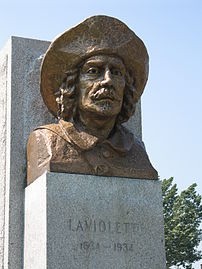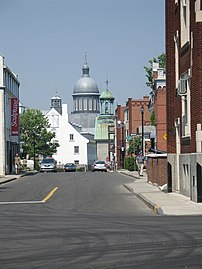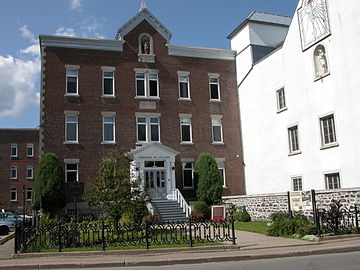Trois-Rivières
Trois-Rivières | |
|---|---|
| Ville de Trois-Rivières | |
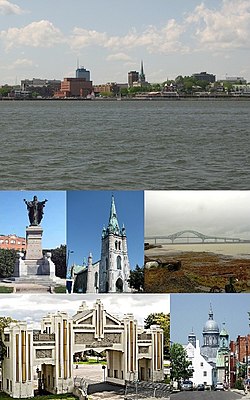 Trois-Rivières seen from the St. Lawrence River. | |
| Motto(s): Deus nobiscum quis contra ("If God is with us, who can be against us") | |
 Trois-Rivières metropolitan area | |
| Country | |
| Province | |
| Region | Mauricie |
| RCM | None |
| Founded | July 4, 1634 by Laviolette |
| Incorporated | June 10, 1857 |
| Constituted | January 1, 2002 |
| Government | |
| • Type | Trois-Rivières City Council |
| • Mayor | Yves Lévesque |
| • Federal riding | Berthier—Maskinongé and Trois-Rivières |
| • Prov. riding | Champlain and Maskinongé and Trois-Rivières |
| Area | |
• City | 333.70 km2 (128.84 sq mi) |
| • Land | 288.90 km2 (111.54 sq mi) |
| • Urban | 177.25 km2 (68.44 sq mi) |
| • Metro | 1,041.15 km2 (401.99 sq mi) |
| Elevation | 61 m (200 ft) |
| Population (2011)[2] | |
• City | 131,338 |
| • Density | 454.6/km2 (1,177/sq mi) |
| • Urban | 126,460 |
| • Urban density | 713.5/km2 (1,848/sq mi) |
| • Metro | 151,773 |
| • Metro density | 145.8/km2 (378/sq mi) |
| • Pop 2006-2011 | |
| • Dwellings | 65,528 |
| Demonym | Trifluvians |
| Time zone | UTC−5 (EST) |
| • Summer (DST) | UTC−4 (EDT) |
| Postal code(s) | |
| Area code | 819 |
| Highways | |
| Website | www |
Trois-Rivières (French pronunciation: [tʁwɑ.ʁi.vjɛʁ], local pronunciation: [tʁwɔ.ʁi.vjaɛ̯ʁ] ) is a city in the Mauricie administrative region of Quebec, Canada, located at the confluence of the Saint-Maurice and Saint Lawrence Rivers, on the north shore of the Saint Lawrence River across from the city of Bécancour. It is part of the densely populated Quebec City–Windsor Corridor and is approximately halfway between Montreal and Quebec City. Trois-Rivières is the economic and cultural hub of the Mauricie region. The settlement was founded on July 4, 1634, the second permanent in New France,[6] after Quebec City in 1608.
The city's name, which is French for three rivers, is named for the fact that the Saint-Maurice River, which is divided by two small islands at the river's opening, has three mouths at the Saint Lawrence River. Traditionally, Trois-Rivières was referred to in English as Three Rivers, although in more recent decades it has been referred to as Trois-Rivières in both English and French. The anglicized name still appears in many areas of the town (e.g., the city's Three Rivers Academy), bearing witness to the influence of English settlers in the town. The city's inhabitants are known as "Trifluviens" (Trifluvians).
Trois-Rivières is also the name of a territory equivalent to a regional county municipality (TE) of Quebec, coextensive with the city of Trois-Rivières. Its geographical code is 371. Together with the regional county municipality of Les Chenaux, it forms the census division (CD) of Francheville (37). The municipalities within Les Chenaux and the former municipalities that were amalgamated into Trois-Rivières formerly constituted the regional county municipality of Francheville. Trois-Rivières is the seat of the judicial district of the same name.[7] The Trois-Rivières metropolitan area also includes the city of Bécancour which is situated on the south shore of the St. Lawrence River across the Laviolette Bridge.
Origin of name
The name of Trois-Rivières, which dates from the end of the XVIth century, is due in fact to an optical illusion. The name in fact refers to the 3 channels that the Saint-Maurice River forms at its mouth with the Saint Lawrence in elapsing between two islands, the island of Potherie and the Saint-Quentin island. The city occupies a location known to the French since 1535 when Jacques Cartier, in a trip along the St. Lawrence, stopped to plant a cross on Saint-Quentin island. But the Three Rivers name is used for the first time in 1599 by Sieur François Gravé Du Pont, a geographer at the use of Champlain, which confirms the name in 1603. Sieur Gravé Du Pont as he sails river towards Montreal, sees little intervals a first tributary of the river, a strip of land, a second tributary, another strip of land, and finally a third tributary it takes even to a different river. He did not know then that two large islands divide the course of the Saint-Maurice River in three parts where the latter flows into the St. Lawrence river.
History
For a long time, the area that would later become known as Trois-Rivières was frequented by Algonquins and Abenakis, who used it as a summer stopping place. The French explorer Jacques Cartier described the site while on his second journey to the New World in 1535. The name "Trois-Rivières", however, was given only in 1599, by Captain Dupont-Gravé, and first appeared on maps of the area in 1601.[8]
In 1603, while surveying the Saint-Lawrence River, Samuel de Champlain recommended establishing a permanent settlement in the area, which was finally done on July 4, 1634, by the Sieur of Laviolette. Additional inhabitants of the original city of Trois-Rivières include: Quentin Moral, Sieur de St. Quentin; Pierre Boucher, Jacques Le Neuf, Jean Godefroy de Lintot, Michel Le Neuf du Hérisson, François Hertel, François Marguerie, René Robineau, and Jean Sauvaget.[9] The city was the second to be founded in New France (after Quebec City, before Montreal) and – thanks to its strategic location – played an important role in the colony and in the fur trade. The settlement became the seat of a regional government in 1665. Ursuline nuns first arrived at the settlement in 1697, establishing the first school and helping local missionaries to Christianize the local Aboriginals and Métis.
French sovereignty in Trois-Rivières continued until 1760, when the city was captured as part of the British conquest of Quebec. Sixteen years later, on June 8, 1776, it was the theatre of the Battle of Trois-Rivières (part of the ill-fated invasion of the province of Quebec by Americans from the Boston area—les Bostonnais) during the American Revolutionary War.
Trois-Rivières continued to grow in stature throughout the period and beyond; in 1792 it became the seat of a judicial district and in 1852, that of a Roman Catholic diocese, the Diocese of Trois-Rivières.
Long before the Royal Military College of Canada was established in 1876, Captain A.G. Douglas, a former adjutant at the British military college at Great Marlow, recommended in 1816 the establishment of a military college open to Catholic and Protestant boys at Trois-Rivières in a disused government house with himself as superintendent. Douglas' college was intended as a boarding school to educate the young sons of officers, amongst others, in Latin, English language, French Language, History, Geography, Drawing and Mathematics.[10]
In 1908, the greater part of the city of Trois-Rivières was destroyed by a fire in which the majority of the city's original buildings, many dating back to French colonial years, were destroyed. Only a few were spared, including the Ursuline Monastery and the De Tonnancour Manor. As a result of the destruction, a major redesign and renovation of the city was undertaken, including the widening and renewal of many of the city's roads. As well, many new businesses and industries became established in the town, which attracted many new residents.
In the 1960s, Trois-Rivières undertook a large-scale project of economic diversification, including the establishment of several cultural institutions and attractions. The Old City of Trois-Rivières was declared an "historic sector" in 1964. The Laviolette Bridge, linking Trois-Rivières to Bécancour and the south shore of the Saint-Lawrence River, was opened officially on December 20, 1967. Finally, in 1969, the city appeared on Canada's academic map with the establishment of the Université du Québec à Trois-Rivières, known for its chiropractic school, its podiatric medical education and its excellent programs for primary and secondary school education.
Although historically an important center of commerce, trade and population, Trois-Rivières has relinquished much of its earlier importance to the two major cities of Quebec: the metropolis of Montreal and the capital of Quebec City. It does, however, remain one of the principal medium-sized cities of Quebec, along with Saguenay, Sherbrooke and Gatineau.
-
The Sieur de Laviolette, founder of Trois-Rivières. The Laviolette Bridge is his namesake.
-
Architecture in old Trois-Rivières.
-
The front of the Ursulines Monastery, on rue des Ursulines.
Cityscape
The city's main thoroughfare is Boulevard des Forges, an area several blocks long in the heart of the Old Town composed of century-old buildings housing a great variety of cafés, restaurants, clubs, bars, and shops. In the warmer months, the area is regularly closed to vehicular traffic to accommodate various festivals and events, turning the downtown core into a pedestrian mall.
Notable landmarks include the Forges du Saint-Maurice, a foundry dating back to the 1730s, the Ursulines Monastery, and Notre-Dame-du-Cap Basilica.
Economy

Trois-Rivières is Canada's oldest industrial city, with its first foundry established in 1738.[11] The forge produced iron and cast for 150 years, much of it being shipped to France to be used in French navy ships.[12] The first port facility was built in 1818 near rue Saint-Antoine, and today handles 2.5 million tonnes of cargo annually.[13] The first railway was built in 1879 to support the growing lumber industry.[14]
The city was known as the pulp and paper industry capital of the world from the late 1920s until the early 1960s.[15] The city once had five mills in operation (Trois-Rivières Ouest, Wayagamack, C.I.P. and St-Maurice Paper). Today, there are three mills left operating (Kruger Trois-Rivières Ouest, Kruger Wayagamack and Cascades Lupel ex-St-Maurice Paper), the closures due largely to a decline in newsprint demand and globalization. The closures were not limited to just the pulp and paper industry; Trois-Rivières experienced an industrial decline in the 1980s and 1990s, with the closure of several textile mills, with unemployment rising to 14 percent in the 1990s.[16]
Trois-Rivières is attempting an industrial revitalization by establishing technology parks and taking advantage of its central location to both Montreal and Quebec City, its university and port. An example of the new economy is Marmen Incorporated, which manufactures wind turbine towers and employs 1,000 people between its operations in Trois-Rivières and Matane.
The city's other prominent industries include metal transformation, electronics, thermoplastics, as well as cabinet making and the production of food crops. An industrial park adjoining Trois-Rivières Airport serves also as a major centre for the aeronautical industry.
Climate
The area has a humid continental climate (Köppen Dfb). Winters are long, cold, and snowy: the January high is −7.1 °C (19.2 °F), with lows dropping to −20 °C (−4 °F) on 27 nights per year and to −30 °C (−22 °F) on 2.9 nights.[17] Snowfall averages 259 centimetres (102 in), with reliable snow cover from December to March.[17] Summers are warm, with an average July high of 25.5 °C (77.9 °F), and high temperatures reach 30 °C (86 °F) on 5.5 days per summer.[17] Spring and autumn are short and crisp. Precipitation averages 1,123 millimetres (44.2 in), and is the greatest during summer.
| Climate data for Trois-Rivières (1981−2010) | |||||||||||||
|---|---|---|---|---|---|---|---|---|---|---|---|---|---|
| Month | Jan | Feb | Mar | Apr | May | Jun | Jul | Aug | Sep | Oct | Nov | Dec | Year |
| Record high °C (°F) | 13.0 (55.4) |
11.0 (51.8) |
17.5 (63.5) |
31.5 (88.7) |
32.2 (90.0) |
34.5 (94.1) |
34.5 (94.1) |
36.1 (97.0) |
32.5 (90.5) |
27.2 (81.0) |
20.0 (68.0) |
12.5 (54.5) |
36.1 (97.0) |
| Mean daily maximum °C (°F) | −7.1 (19.2) |
−4.4 (24.1) |
1.4 (34.5) |
9.9 (49.8) |
18.2 (64.8) |
23.3 (73.9) |
25.5 (77.9) |
24.4 (75.9) |
19.4 (66.9) |
11.9 (53.4) |
4.1 (39.4) |
−3.1 (26.4) |
10.3 (50.5) |
| Daily mean °C (°F) | −12.1 (10.2) |
−9.7 (14.5) |
−3.6 (25.5) |
4.8 (40.6) |
12.3 (54.1) |
17.6 (63.7) |
20.0 (68.0) |
18.9 (66.0) |
14.2 (57.6) |
7.4 (45.3) |
0.5 (32.9) |
−7.4 (18.7) |
5.2 (41.4) |
| Mean daily minimum °C (°F) | −17.1 (1.2) |
−14.9 (5.2) |
−8.6 (16.5) |
−0.3 (31.5) |
6.3 (43.3) |
11.8 (53.2) |
14.4 (57.9) |
13.4 (56.1) |
8.9 (48.0) |
2.8 (37.0) |
−3.1 (26.4) |
−11.6 (11.1) |
0.2 (32.4) |
| Record low °C (°F) | −41.1 (−42.0) |
−35.6 (−32.1) |
−35.0 (−31.0) |
−17.2 (1.0) |
−6.1 (21.0) |
−1.5 (29.3) |
3.5 (38.3) |
1.1 (34.0) |
−7.2 (19.0) |
−10.6 (12.9) |
−25.6 (−14.1) |
−35.5 (−31.9) |
−41.1 (−42.0) |
| Average precipitation mm (inches) | 82.9 (3.26) |
68.8 (2.71) |
75.6 (2.98) |
79.2 (3.12) |
96.3 (3.79) |
107.0 (4.21) |
116.8 (4.60) |
101.3 (3.99) |
100.6 (3.96) |
98.4 (3.87) |
102.4 (4.03) |
93.4 (3.68) |
1,122.8 (44.20) |
| Average rainfall mm (inches) | 24.5 (0.96) |
19.5 (0.77) |
32.0 (1.26) |
66.8 (2.63) |
96.3 (3.79) |
107.0 (4.21) |
116.8 (4.60) |
101.3 (3.99) |
100.6 (3.96) |
95.7 (3.77) |
75.4 (2.97) |
28.1 (1.11) |
863.9 (34.01) |
| Average snowfall cm (inches) | 58.5 (23.0) |
49.3 (19.4) |
43.6 (17.2) |
12.5 (4.9) |
0.0 (0.0) |
0.0 (0.0) |
0.0 (0.0) |
0.0 (0.0) |
0.0 (0.0) |
2.8 (1.1) |
27.1 (10.7) |
65.3 (25.7) |
259.0 (102.0) |
| Average precipitation days (≥ 0.2 mm) | 13.9 | 11.9 | 11.1 | 11.9 | 14.4 | 14.4 | 15.0 | 12.8 | 12.8 | 14.3 | 14.4 | 14.2 | 161.1 |
| Average rainy days (≥ 0.2 mm) | 2.9 | 2.6 | 5.4 | 10.5 | 14.4 | 14.4 | 15.0 | 12.8 | 12.8 | 14.2 | 10.4 | 4.0 | 119.5 |
| Average snowy days (≥ 0.2 cm) | 12.3 | 10.3 | 7.0 | 2.7 | 0.07 | 0.0 | 0.0 | 0.0 | 0.0 | 0.65 | 5.6 | 11.5 | 50.2 |
| Source: Environment Canada[17] | |||||||||||||
Culture

Trois-Rivières hosts the FestiVoix de Trois-Rivières, a 10-day summer music festival which attracts in excess of 300,000 visitors annually.[18] The city also hosts the Festival International de la Poésie – an international poetry festival – as well as the Festival International Danse Encore,[19] and the MetalFest de Trois-Rivières every November. In 2009, Trois-Rivières was designated as the 2009 Cultural Capital of Canada for cities having a population of 125,000 or more.[20]
Trois-Rivières is officially the "Poetry Capital of Quebec"[21][22] and numerous plaques displaying poetic verses are installed throughout the centre of the city, and its International Festival of Poetry (held each year in the first week of October) honours this title.
Demographics
| Year | Pop. | ±% |
|---|---|---|
| 1871 | 11,107 | — |
| 1881 | 12,340 | +11.1% |
| 1891 | 11,784 | −4.5% |
| 1901 | 13,540 | +14.9% |
| 1911 | 18,445 | +36.2% |
| 1921 | 33,072 | +79.3% |
| 1931 | 48,699 | +47.3% |
| 1941 | 59,685 | +22.6% |
| 1951 | 72,154 | +20.9% |
| 1956 | 83,189 | +15.3% |
| 1961 | 93,451 | +12.3% |
| 1966 | 99,974 | +7.0% |
| 1971 | 103,703 | +3.7% |
| 1976 | 106,031 | +2.2% |
| 1981 | 111,453 | +5.1% |
| 1986 | 114,675 | +2.9% |
| 1991 | 121,483 | +5.9% |
| 1996 | 124,417 | +2.4% |
| 2001 | 122,395 | −1.6% |
| 2006 | 126,323 | +3.2% |
| 2011 | 131,338 | +4.0% |
| 2014[25] | 134,802 | +2.6% |
| [23][24] | ||
Prior to amalgamation in 2001, the new city of Trois-Rivières was divided among six municipalities. The largest visible minority groups in Trois-Rivières are Blacks (2.2%) and Asians (1.4%).
Municipal population, pre-amalgamation (December 14, 2000)[26]
| Municipality | Population |
|---|---|
| Trois-Rivières | 48 285 |
| Cap-de-la-Madeleine | 32 927 |
| Trois-Rivières-Ouest | 24 170 |
| Saint-Louis-de-France | 7 798 |
| Pointe-du-Lac | 6 846 |
| Sainte-Marthe-du-Cap | 6 428 |
| Total | 126 454 |
Age structure
- 0–14 years: 16.1%
- 15–64 years: 68.6%
- 65 years and over: 15.3%
Religious groups
- Catholic: 93.7%
- Protestant and other Christian: 2.7%
- No religious affiliation: 3.3%
Administration
City Council
Since its incorporation in 1845, the city has had thirty-six mayors. The mayor presides over the Trois-Rivières City Council.
Municipal reorganization
On January 1, 2002, the former city of Trois-Rivières along with its neighbouring towns of Cap-de-la-Madeleine, Sainte-Marthe-du-Cap, Saint-Louis-de-France, Trois-Rivières-Ouest, and the municipality of Pointe-du-Lac, were combined to form the new city of Trois-Rivières.
Sport
Trois-Rivières has an internationally known racetrack named Circuit Trois-Rivières. The track hosts American Le Mans Series, SCCA Pro Racing Trans-Am Series, Star Mazda Series, World RX of Canada and the NASCAR Canadian Tire Series events.[27]
In baseball, Trois-Rivières is represented by the Canadian American Association of Professional Baseball's Trois-Rivières Aigles which play their home games at Stade Stereo+. In ice hockey, Trois-Rivières is represented by the Trois-Rivières Blizzard of the Ligue Nord-Américaine de Hockey, which play their home games at the Colisée de Trois-Rivières. The city is also the site of the only remaining pari-mutuel (wagering) harness racing track in Quebec, Hippodrome de Trois-Rivières, which currently operates live standardbred racing from May through October. In 2014, the hippodrome has resurrected the Prix d'Été, a once major Canadian race for four-year-old pacers that had been contested in Montreal until 1992.
Transportation
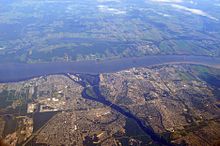
Local bus service is provided by the Société de transport de Trois-Rivières. The Laviolette Bridge links Trois-Rivières to Bécancour of the Centre-du-Québec administrative region on the south shore of the Saint Lawrence River. The Laviolette Bridge is the only bridge across the Saint Lawrence River between Montreal and Quebec City; therefore it provides an important connection between the north and south shores of the river. Known for its impressive structure, its elegant aesthetics, the bridge has become a major landmark of Trois-Rivières and the Mauricie region. Approximately 28,000 vehicles cross the bridge each day. An airport also serves the city.
On April 8, 2014 during morning commute an SUV fell into a giant pothole in Trois-Rivières caused by heavy rain accumulation. Nobody was injured during the incident.[28]
Media
Islands

The Saint-Quentin Island lies at the confluence of the Saint-Maurice River and St. Lawrence River in the city of Trois-Rivières. It is with islands "Saint-Christophe and "De La Poterie", the origin of the name of the city, in reference to the three channel that the Saint-Maurice River forms at its mouth with the St. Lawrence River flowing between two islands. It owes its name to the judge said Quentin Moral, said Saint-Quentin, fur trader and one of the first dealers on this island.[29] It is now a center of popular outdoor activities and relaxation at the hearth of city. The patron saint of the island is Quentin de Rome.
It was first inhabited by an Algonquin tribe that there was corn (Indian corn in Quebec slang). Thereafter, the October 7, 1535, Jacques Cartier planted a cross on the island proclaiming sovereignty of French on this territory. The natural environment of the island Saint-Quentin remained virtually unchanged; it remained virtually unused from eighteenth century until the end of the nineteenth century.
From the 1930, the recreational aspect of the island became important. The island belonged at the time to Quebec Savings and Trust Company Limited and the Canada Power and Paper Corporation was the subject of a bid from the City in 1933, but it was not until November 3, 1947 that the land is owned by the city. Meanwhile, it served as training camp for the Royal Canadian Navy. Services were gradually introduced in 1950.
The park and the beach on the island Saint-Quentin were officially inaugurated on June 24, 1962, in the presence of 5,000 people, when there were over 100 000 visitors.[30] Since then, the island welcomed many facilities, including a marina, a bike path, an interpretative trail, an ice rink and a camping. Several happenings and festivals are held annually on the island.
Notables

- Jean Victor Allard, first francophone Chief of the Defence Staff
- Jean-Christophe Beaulieu, Canadian football player
- Steve Bégin, NHL hockey player
- Jean Béliveau, retired NHL hockey player for the Montreal Canadiens, inducted into the Hockey Hall of Fame in 1972
- Marc-André Bergeron, NHL hockey player
- Guy Bertrand, radio-TV personality and CBC French Radio and Television official linguistic advisor (French links:fr:C'est bien meilleur le matin)[31]
- Pierre Boucher, 1654 Governor of Trois Rivieres, Quebec, Canada and the official interpreter and agent to the Indian Tribes
- John Conley, politician
- Jacques De Noyon, worked in the fur trade as a coureur de bois, in 1688 he led an expedition beyond Lake Superior into territory previously unknown to fur traders, he was the first white man to explore this region[32]
- Médard Des Groseilliers and Pierre-Esprit Radisson, explorers, fur traders, founders of the Hudson's Bay Company[33]
- Maurice Duplessis, former Premier of Quebec (1936–39, 1944–59)
- André Dupont, former NHL hockey player
- Madeleine Ferron, writer
- Gérald Godin, politician and poet
- Annie Groovie, children's book author
- Jean Grou, an original settler of Trois-Rivières with a national monument localized at his original farm Coulèe Grou
- Aaron Hart, businessman
- Ezekiel Hart, entrepreneur and politician, and the first Jew to be elected to public office in the British Empire
- Norman Iceberg, a Canadian singer-songwriter
- Simon Kean, super heavyweight boxer who qualified to represent Canada in the 2012 Olympics
- Claude G. Lajoie, federal liberal politician (elected in 1971, 1972, 1974, 1979, 1980), building contractor, businessman
- Félix Leclerc, songwriter; worked in a Trois-Rivières radio station
- Eisha Marjara, Indo-Canadian filmmaker[34]
- Martyr, a technical death metal band
- The New Cities, a Canadian rock band, notable for their song "Dead End Countdown"
- Ghyslain Raza, president of the Trois-Rivieres Heritage Society, one of the first "internet celebrities" (the Star Wars Kid)[35]
- René Robert, former NHL hockey player
- Jean-Guy Talbot, former NHL hockey player, an arena with his name
- Éric Thériault, comic book artist and writer
- Luc Tousignant, the only French Canadian to start as quarterback in the Canadian Football League (Montreal Concordes)
- Denis Villeneuve, a French-Canadian Oscar nominated film director (Incendies, Prisoners, Enemy, ..)
- Henri Wittmann, linguist
- Mikaël Zewski, light middleweight professional boxer
-
2
Sister city
This section needs additional citations for verification. (May 2015) |
 Châteaudun, France
Châteaudun, France Tours, France
Tours, France
See also
- List of regional county municipalities and equivalent territories in Quebec
- 1925 Charlevoix–Kamouraska earthquake
- Marcel-Léger Ecological Reserve
- List of governors of Trois-Rivières
- List of towns in New France
- List of population centres in Quebec
- List of towns in Quebec
References
- ^ a b "Répertoire des municipalités: Geographic code 37067". www.mamh.gouv.qc.ca (in French). Ministère des Affaires municipales et de l'Habitation.
- ^ a b "Census Profile — Trois-Rivières". Canada 2011 Census. Statistics Canada. 2012-02-08. Retrieved 24 May 2012.
- ^ a b "Census Profile — Trois-Rivières, Population Centre". Canada 2011 Census. Statistics Canada. 2012-02-08. Retrieved 24 May 2012.
- ^ a b "Census Profile — Trois-Rivières, Census Metropolitan Area". Canada 2011 Census. Statistics Canada. 2012-02-08. Retrieved 24 May 2012.. The census metropolitan area consists of Trois-Rivières, Bécancour, Champlain, Saint-Luc-de-Vincennes, Saint-Maurice, Wôlinak, Yamachiche. In the 2006 census, the census metropolitan area had not included Saint-Luc-de-Vincennes or Yamachiche.
- ^ "Banque de noms de lieux du Québec: Reference number 63803". toponymie.gouv.qc.ca (in French). Commission de toponymie du Québec.
- ^ Roy-Sole, Monique. "A Tale of Tenacity", Canadian Geographic Magazine, April 2009, Vol. 129, No. 2, p. 31.
- ^ Territorial Division Act. Revised Statutes of Quebec D-11.
- ^ untitled[dead link]
- ^ Report Concerning the Archives of Canada for the year 1905. Vol I. of III., p. li.
- ^ Richard Preston 'Canada's RMC: A History of the Royal Military College of Canada' published by the RMC Club by U of Toronto Press.
- ^ "Forges du Saint-Maurice National Historic Site of Canada". Parks Canada. Retrieved 2009-03-27.
- ^ Roy-Sole, Monique. "A Tale of Tenacity", Canadian Geographic Magazine, April 2009, Vol. 129, No. 2, p. 32
- ^ "Le Port de Trois-Rivières". Retrieved 2009-03-27.
- ^ Roy-Sole, Monique. "A Tale of Tenacity", Canadian Geographic Magazine, April 2009, Vol. 129, No. 2, p. 35
- ^ Roy-Sole, Monique. "A Tale of Tenacity", Canadian Geographic Magazine, April 2009, Vol. 129, No. 2, p. 36
- ^ Roy-Sole, Monique. "A Tale of Tenacity", Canadian Geographic Magazine, April 2009, Vol. 129, No. 2, p. 37
- ^ a b c d "Trois-Rivières". Canadian Climate Normals 1981–2010. Environment Canada. Retrieved May 12, 2014.
- ^ "Le FestiVoix de Trois-Rivières". Retrieved 2009-04-03.
- ^ "Accueil". Festival encore. Retrieved 2012-07-07.
- ^ Roy-Sole, Monique. "A Tale of Tenacity", Canadian Geographic Magazine, April 2009, Vol. 129, No. 2, p. 38
- ^ "Tourisme Trois-Rivières".
- ^ "Festival International de la Poésie".
- ^ "Évolution démographique des 10 principales villes du Québec (sur la base de 2006) selon leur limites territoriales actuelles1, Recensements du Canada de 1871 à 2006" (in French). Institut de la statistique du Québec. 2008-02-01. Retrieved 2012-02-08.
- ^ These figures correspond to the territory of the city of Trois-Rivières following the municipal reorganizations of 2002 and 2006.
- ^ http://www.mamrot.gouv.qc.ca/repertoire-des-municipalites/fiche/municipalite/37067/
- ^ "Ville de Trois-Rivières". Laville.v3r.net. Retrieved 2012-07-07.
- ^ "Grand Prix de Trois-Rivières". Gp3r.com. Retrieved 2012-07-07.
- ^ http://www.cbc.ca/news/canada/montreal/giant-pothole-swallows-suv-in-trois-rivi%C3%A8res-1.2602793?cmp=fbtl
- ^ Ile-St-Quentin
- ^ City of Trois-Rivières
- ^ "Le français au micro | zone radio". Radio-Canada.ca. Retrieved 2012-01-02.
- ^ "Jacques de Noyon 1668-1745". Ontarioplaques.com. Retrieved 2012-07-07.
- ^ http://www.cbc.ca/history/EPCONTENTSE1EP6CH1PA5LE.html Hudson's Bay Company Beginnings. Retrieved on 2015-02-11.
- ^ Black, Barbara. "Air India disaster hit Concordia hard" (Archive). Conordia's Thursday Report. April 21, 2005. Volume 29, No. 14. Retrieved on November 22, 2014.
- ^ WHERE ARE THEY NOW? The 'Star Wars Kid' Sued The People Who Made Him Famous. Business Insider (2010-05-12). Retrieved on 2013-07-12.
External links
- Template:Fr icon Official site of Trois-Rivières
- Tourisme Mauricie Regional tourist office
- Tourisme Trois-Rivières Municipal tourist office
- Template:Fr icon Troisrivieresplus.net
- Template:Fr icon Répertoire des clubs de golf de Trois-Rivières
- Template:Fr icon Le Nouvelliste
- Grand-Prix de Trois-Rivières
- Pictures of Trois-Rivières (2001 to date)



